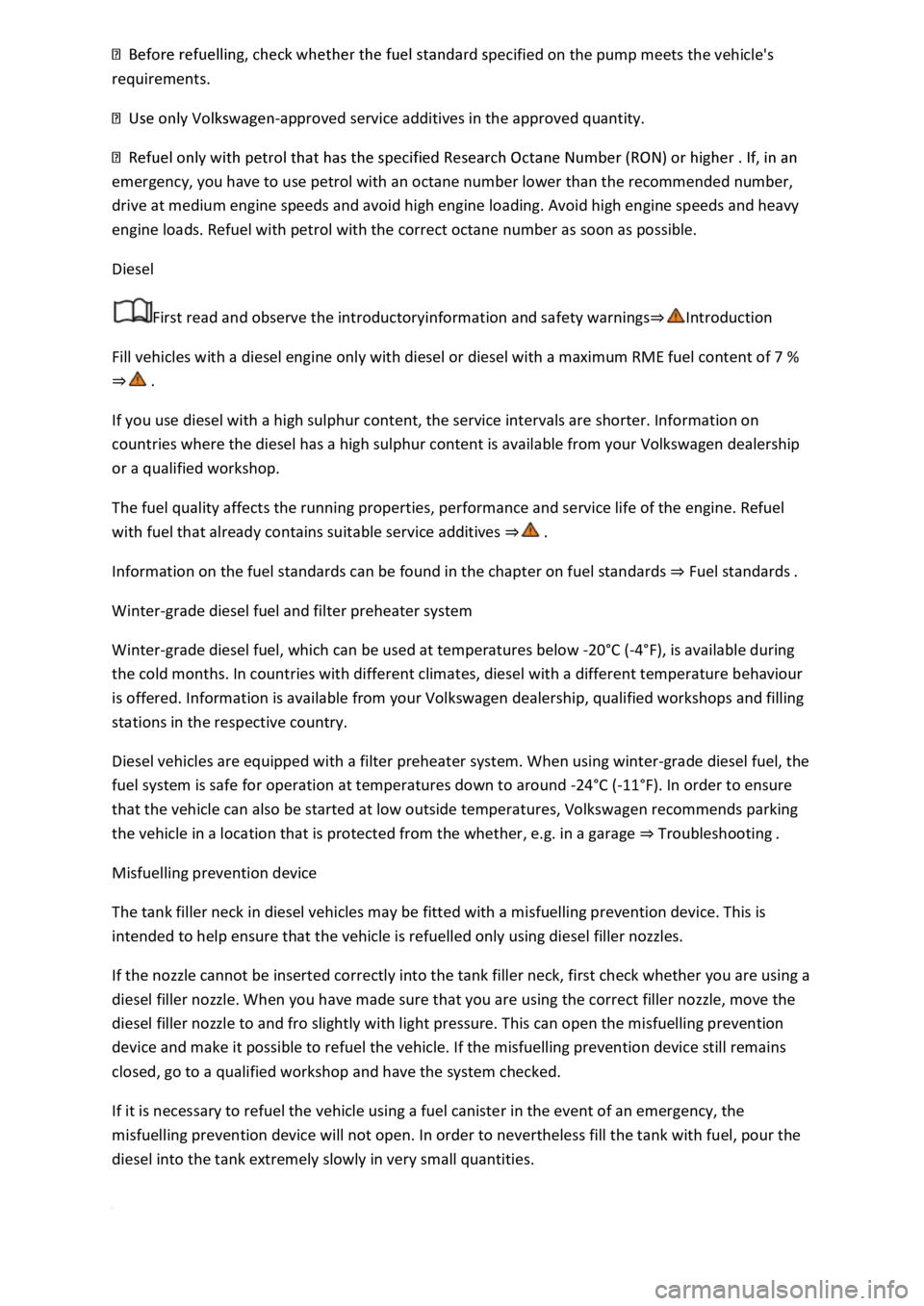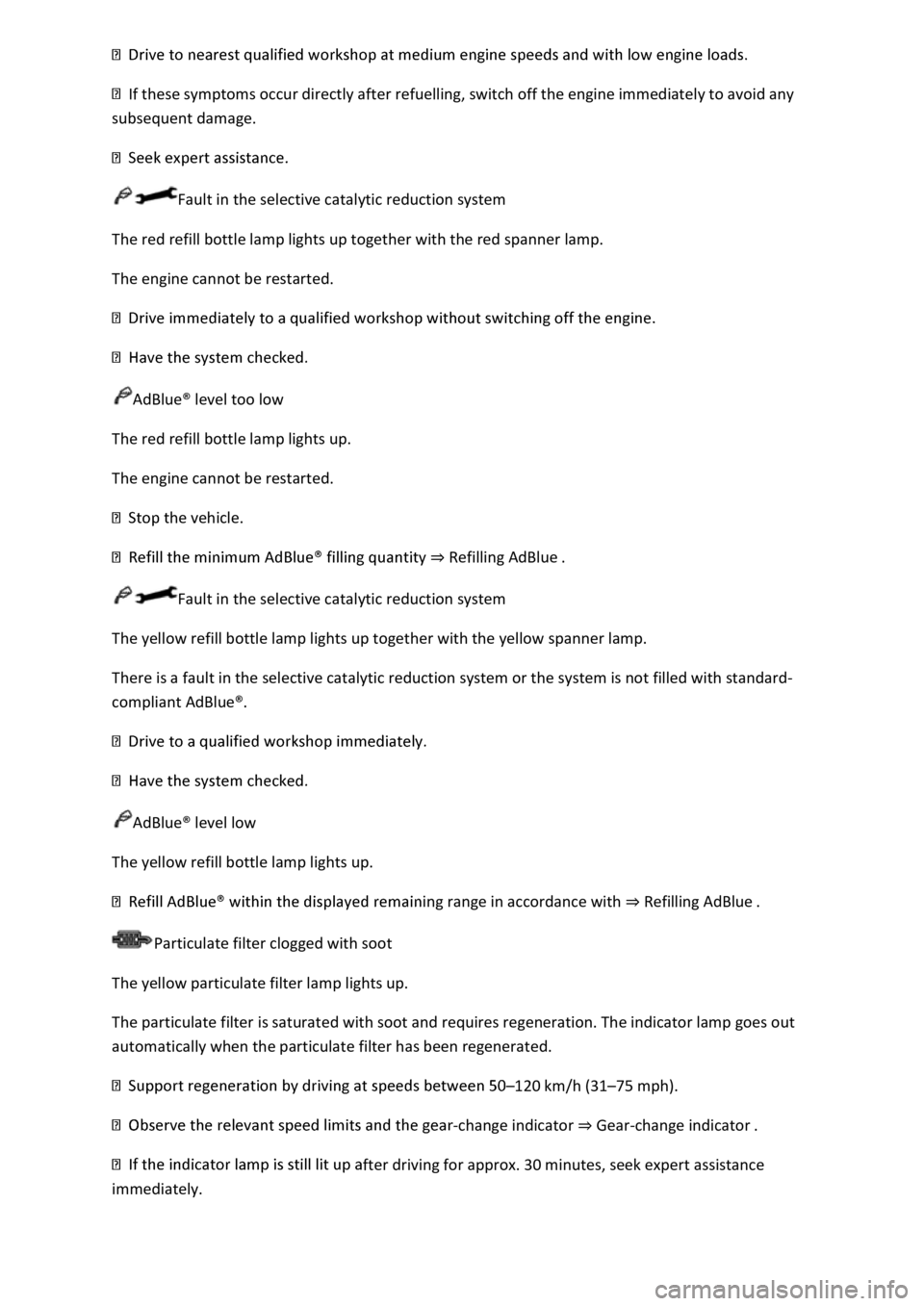2021 VOLKSWAGEN T-ROC light
[x] Cancel search: lightPage 321 of 502

-knife on slippery roads with little grip even if the towing vehicle is equipped
with trailer stabilisation.
er
socket is being used without a trailer (e.g. for a bicycle carrier with lighting).
Retrofitting a towing bracket
Fig. 157 Dimensions and mounting points for retrofitting a towing bracket.
First read and observe the introductoryinformation and safety warnings⇒Introduction
Volkswagen recommends having the towing bracket retrofitted by a qualified workshop. The cooling
system may need to be modified or heat shields may need to be fitted. Volkswagen recommends
using a Volkswagen dealership for this purpose.
Dimensions
The dimensions ⇒ Fig. 157 must be observed in all cases when retrofitting a towing bracket. Always
observe the minimum distance given from the middle of the ball head Ⓓ to the surface of the road.
This also applies when the vehicle is fully laden, including maximum drawbar load.
Page 324 of 502

Information on warning and indicator lamps that light up can be found in the section
Troubleshooting ⇒ Troubleshooting .
Fuel standards
First read and observe the introductoryinformation and safety warnings⇒Introduction
Petrol
EN 228
DIN 51626-1
Diesel
EN 590
EN 590
Where fuel complying with the specified standard is not available, your Volkswagen dealership or a
qualified workshop will have information on which available fuels are suitable for the vehicle.
NOTICE
Using fuel that does not comply with these standards may reduce performance and cause damage to
the engine and fuel system.
and engine failure.
Petrol
First read and observe the introductoryinformation and safety warnings⇒Introduction
Fill vehicles with a petrol engine only with unleaded petrol or petrol with a maximum ethanol
content of 10 % (E10) ⇒ .
Fuel grades differ according to the octane number. The vehicle may be filled with petrol that has a
higher octane number than the engine requires. However, this does not provide any advantage in
terms of fuel consumption or engine output.
The fuel quality affects the running properties, performance and service life of the engine. Refuel
with fuel that already contains suitable service additives ⇒ .
Information on the fuel standards can be found in the chapter on fuel standards ⇒ Fuel standards .
NOTICE
Errors during refuelling or unsuitable fuel additives may cause damage to the vehicle.
Page 325 of 502

pecified on the pump meets the vehicle's
requirements.
-approved service additives in the approved quantity.
emergency, you have to use petrol with an octane number lower than the recommended number,
drive at medium engine speeds and avoid high engine loading. Avoid high engine speeds and heavy
engine loads. Refuel with petrol with the correct octane number as soon as possible.
Diesel
First read and observe the introductoryinformation and safety warnings⇒Introduction
Fill vehicles with a diesel engine only with diesel or diesel with a maximum RME fuel content of 7 %
⇒ .
If you use diesel with a high sulphur content, the service intervals are shorter. Information on
countries where the diesel has a high sulphur content is available from your Volkswagen dealership
or a qualified workshop.
The fuel quality affects the running properties, performance and service life of the engine. Refuel
with fuel that already contains suitable service additives ⇒ .
Information on the fuel standards can be found in the chapter on fuel standards ⇒ Fuel standards .
Winter-grade diesel fuel and filter preheater system
Winter-grade diesel fuel, which can be used at temperatures below -20°C (-4°F), is available during
the cold months. In countries with different climates, diesel with a different temperature behaviour
is offered. Information is available from your Volkswagen dealership, qualified workshops and filling
stations in the respective country.
Diesel vehicles are equipped with a filter preheater system. When using winter-grade diesel fuel, the
fuel system is safe for operation at temperatures down to around -24°C (-11°F). In order to ensure
that the vehicle can also be started at low outside temperatures, Volkswagen recommends parking
the vehicle in a location that is protected from the whether, e.g. in a garage ⇒ Troubleshooting .
Misfuelling prevention device
The tank filler neck in diesel vehicles may be fitted with a misfuelling prevention device. This is
intended to help ensure that the vehicle is refuelled only using diesel filler nozzles.
If the nozzle cannot be inserted correctly into the tank filler neck, first check whether you are using a
diesel filler nozzle. When you have made sure that you are using the correct filler nozzle, move the
diesel filler nozzle to and fro slightly with light pressure. This can open the misfuelling prevention
device and make it possible to refuel the vehicle. If the misfuelling prevention device still remains
closed, go to a qualified workshop and have the system checked.
If it is necessary to refuel the vehicle using a fuel canister in the event of an emergency, the
misfuelling prevention device will not open. In order to nevertheless fill the tank with fuel, pour the
diesel into the tank extremely slowly in very small quantities.
Page 327 of 502

Components relevant to emission control
Introduction
This chapter contains information on the followingsubjects:
⇒ Emission control with AdBlue
⇒ Refilling AdBlue
⇒ Catalytic converter
⇒ Particulate filter
⇒ Troubleshooting
⇒ Emission control with AdBlue®
⇒ Catalytic converter
⇒ Particulate filter
Information on warning and indicator lamps that light up can be found in the section
Troubleshooting ⇒ Troubleshooting .
WARNING
Engine emissions contain carbon monoxide which can cause people to lose consciousness. It can also
cause death.
WARNING
The components of the exhaust system become very hot. This can cause fires.
inflammable material underneath the vehicle, e.g. dry grass.
-corrosion coatings to the exhaust pipes, catalytic
converters, particulate filter or the heat shields.
Emission control with AdBlue®
First read and observe the introductoryinformation and safety warnings⇒Introduction
The SCR catalytic converter uses AdBlue® urea solution to convert nitrogen oxides into nitrogen and
water.
Page 331 of 502

First read and observe the introductoryinformation and safety warnings⇒Introduction
⇒ Petrol .
⇒ Refuelling .
⇒ Checking the engine oil level and refilling the engine oil .
⇒ Jump starting the vehicle .
If you notice misfiring, loss of power or uneven running when driving, reduce speed immediately and
have the vehicle checked by a qualified workshop ⇒ Troubleshooting . Otherwise unburnt fuel can
enter the exhaust system and escape into the atmosphere. The catalytic converter can also be
damaged by overheating.
The emissions may have a sulphur-like smell even when the exhaust purification system is working
properly.
Particulate filter
First read and observe the introductoryinformation and safety warnings⇒Introduction
Function
⇒ Fuel standards .
⇒ Refuelling .
⇒ Engine oil standards .
⇒ Jump starting the vehicle .
Periodic regeneration
The soot in the particulate filter is burnt off at high temperatures on a periodic basis.
To assist the regeneration of the particulate filter, Volkswagen recommends that you avoid making
only short journeys.
Noises, slight smells and increased engine speeds may occur during regeneration. The radiator fan
may run on while the vehicle is moving or when the engine has been switched off.
During the periodic regeneration process, the yellow indicator lamp does not light up.
Troubleshooting
First read and observe the introductoryinformation and safety warnings⇒Introduction
Irregular engine running and faults
Page 332 of 502

If these symptoms occur directly after refuelling, switch off the engine immediately to avoid any
subsequent damage.
Fault in the selective catalytic reduction system
The red refill bottle lamp lights up together with the red spanner lamp.
The engine cannot be restarted.
AdBlue® level too low
The red refill bottle lamp lights up.
The engine cannot be restarted.
he vehicle.
⇒ Refilling AdBlue .
Fault in the selective catalytic reduction system
The yellow refill bottle lamp lights up together with the yellow spanner lamp.
There is a fault in the selective catalytic reduction system or the system is not filled with standard-
compliant AdBlue®.
AdBlue® level low
The yellow refill bottle lamp lights up.
ing range in accordance with ⇒ Refilling AdBlue .
Particulate filter clogged with soot
The yellow particulate filter lamp lights up.
The particulate filter is saturated with soot and requires regeneration. The indicator lamp goes out
automatically when the particulate filter has been regenerated.
–120 km/h (31–75 mph).
-change indicator ⇒ Gear-change indicator .
fter driving for approx. 30 minutes, seek expert assistance
immediately.
Page 333 of 502

Fault in exhaust system
The yellow catalytic converter lamp lights up or flashes.
Faults in the exhaust system caused by misfiring, which can damage the catalytic converter.
to the nearest qualified workshop immediately.
There may be engine faults and fuel consumption may be higher if the indicator lamps are lit up or
flashing.
If and when
Vehicle toolkit
Introduction
This chapter contains information on the followingsubjects:
⇒ Stowage
⇒ Vehicle toolkit contents
Observe any country-specific legislation when securing your vehicle in the event of a breakdown.
Vehicle toolkit in the vehicle
In vehicles that are factory-fitted with a spare wheel, emergency spare wheel or winter wheels,
additional vehicle tools may be located in the luggage compartment.
WARNING
In the event of a sudden driving or braking manoeuvre or accident, a loose vehicle toolkit,
breakdown set and spare wheel or temporary spare wheel could be flung though the vehicle and
cause severe injuries.
always secured in the luggage compartment.
WARNING
Unsuitable or damaged tools in the vehicle toolkit can lead to accidents and injuries.
Stowage
Page 338 of 502

NOTICE
Damaged or dirty wiper blades can scratch the window glass.
can damage the graphite coating of the wiper blades during cleaning.
Wax deposits from car washes on the windscreen and rear window can cause the wiper blades to
rub. Remove wax residue using a special cleaning product or cleaning cloths.
Changing bulbs
Introduction
This chapter contains information on the followingsubjects:
⇒ Checklist
⇒ Changing bulbs in the front headlights (halogen bulbs)
⇒ Changing the bulbs in the headlights (lights with LED technology)
⇒ Changing the front turn signal bulbs
⇒ Changing bulbs in the front bumper
⇒ Changing bulbs in the tail light clusters (LED lights)
⇒ Changing bulbs in the number plate light (LED lights)
⇒ Troubleshooting
Changing the vehicle bulbs requires a certain amount of technical skill. Volkswagen therefore
recommends having bulbs replaced by a qualified workshop if you are uncertain. The work must be
performed by an expert if other vehicle parts around the affected bulbs need to be removed.
Volkswagen recommends having bulbs replaced by a Volkswagen dealership.
You should keep a box with spare light bulbs for the lights that ensure the vehicle is roadworthy in
the vehicle at all times. Spare bulbs are available from Volkswagen dealerships. In some countries it
is a legal requirement to have these spare bulbs in the vehicle.
It may be illegal to drive with defective lights of the exterior lighting.
Information on indicator and warning lamps can be found in the troubleshooting section at the end
of the chapter ⇒ Troubleshooting .
LED lights on the vehicle
The exterior lighting may feature LEDs: Owners cannot replace the LEDs themselves. If some LEDs
fail, this may be an indication that more elements are on the point of failure. In this case, have the
lights checked and replaced if necessary at a qualified workshop.